Using Technology to Benefit Your Health – Not Harm It
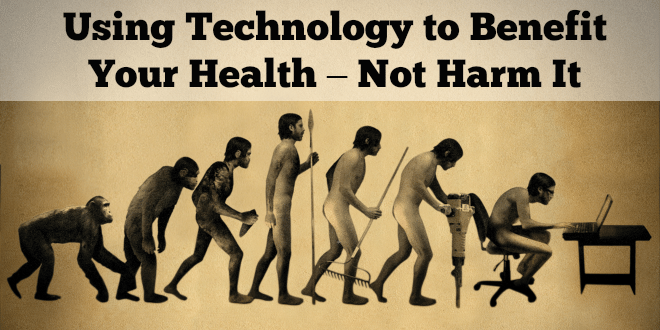
Living a life of health and fitness can be difficult in this new technological era. While many of us eat well, exercise, and stay active in our leisure time, the fact remains that if you’re like 80 percent of the population, you’re still spending over 50 hours a week engaging in a behavior that puts your body and your brain at risk— sitting
.
From commuting to work, working on our computers, and using our cell phones, technology has made it less and less necessary to get any motion at all as we accomplish the activities of our daily lives. Soon you won’t even have to get up to change the heat or turn off the lights (in fact, many have already adopted these behaviors!) But the good news is that there are some people paying attention to this newest health crisis, working day and night developing ways you can get your 9-5 done without doing yourself in. But first...
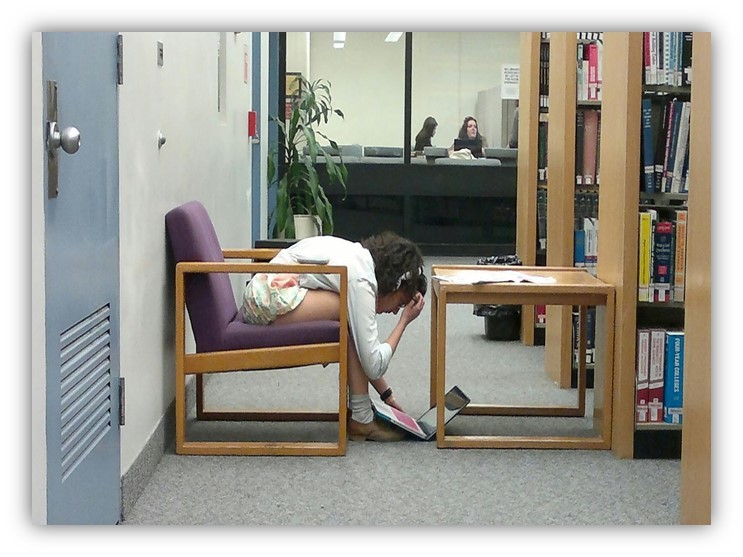
As a chiropractor, the majority of the injuries I treat for in my office are technology related. They come in two forms, one being a repetitive strain injury (RSI). RSIs happen when people sit in incorrect static postures for long periods of time. These incorrect postures put a strain on the musculoskeletal system, resulting in chronic and painful injuries.
The second most common type of injury I treat for is caused by deconditioning syndrome. This is what I believe is responsible for so many of the “CrossFit” injuries reported by the media. When you sit without motion for days, weeks, and months at a time, the body gets out of shape. The smaller stabilizer muscle groups of the body become weak, ligaments are stiff or elongated, and joints are out of place. We then go to the gym and push our bodies to the max, or we run out to shovel snow, without really warming up, and of course we get hurt. The body is not made to stay still—it’s made to move! And when you put it in a state of dysfunction with long periods of sedentary time, a short warm up (or no warm up at all) isn't enough to avoid injury.
[caption id="attachment_17017" align="aligncenter" width="645"]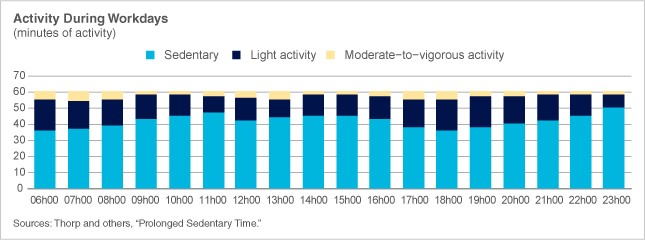 Can't argue with this. Sitting (and lack of movement) is dangerous to our health.[/caption]
Can't argue with this. Sitting (and lack of movement) is dangerous to our health.[/caption]
There’s a third danger to technology that comes as a result of us increasing the amount of time we spend inactive, and that is an increased risk of chronic diseases. Motion is a necessary nutrient for the body, and just like not moving can affect the musculoskeletal system, it can also cause dysfunction to your biochemical processes. Your circulation, metabolism, and brain chemistry are all affected when you don’t move enough. For example, after only one hour of sitting, the body stops producing an enzyme (lipoprotein lipase) that it needs to effectively break down fats and sugars. The result of these long periods of inactivity are associated with higher risks of type 2 diabetes, cancer, heart disease, obesity, and mortality.
So that was the bad news. But the good news is that avoiding the risks brought on by technology is pretty simple to do. You just have to sit less and move more, and when you are sitting, be mindful that you’re doing it with proper posture.
For every hour that you sit, you need to take a two-minute break to move around to prevent those biochemical processes from breaking down. While you’re moving, do more than take a walk. Do some stretches or some resistance exercises that will also help keep your musculoskeletal system healthy and efficient.
When you sit, you want to make sure to keep an S curvature to your spine. Hunching over technology often puts our body into a C-shaped posture that can increase the sheer force your spine is expected to support. Make sure your chest is up, shoulders are back and down, your pelvis is forward, chin is tucked in, and your feet are flat on the floor.
When it comes to technology and your health, it isn’t all bad. In the last few years, there have been some major developments that can actually keep you safe and healthy in this super connected world. Here are some of my favorites:
Healthy Bloggers. Shout out to Dai Manuel! There’s more information and community out there than ever before, so find a blogger that speaks to your personal views on health, and use them as a guide for all things healthy. It’s their job to figure out what’s going on out there and then report it back to you in easy to manage, fun to read, bite-size pieces. Take advantage!
Fitness Apps. Fitness apps are the fastest growing trend in apps today. Your phone can help you diet, exercise, and remind you to move when you've been sedentary too long. With Apple’s new HealthKit on iOS 8, you can compile all of your health and fitness data onto one easy to read screen.
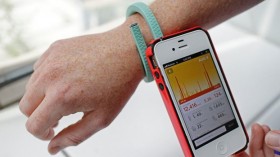 Activity Trackers.
Use these babies to track your steps, your work outs, your posture, and even your sleep. I always tell people if you want to save some money, share one with a friend or a group. Your habits don’t change that often, so take turns using it in weekly increments to get an idea of your overall activity. Added bonus: you’ll have a social network supporting whatever behavior modifications you’re trying to make.
Activity Trackers.
Use these babies to track your steps, your work outs, your posture, and even your sleep. I always tell people if you want to save some money, share one with a friend or a group. Your habits don’t change that often, so take turns using it in weekly increments to get an idea of your overall activity. Added bonus: you’ll have a social network supporting whatever behavior modifications you’re trying to make.
We haven’t seen the last of the research on the negative effects of prolonged sitting, nor have we seen the last of the tech devices that will increase the amount of time you spend being sedentary. Doctors and researchers are now looking at how inactivity affects the brain, creativity, mood, and even cognitive functioning, all while engineers are creating light bulbs and locks that can be controlled by your phone. The take away here is to pay attention, to the research and to your body. If you’re tired, in pain, or getting injured often, there’s probably something you can change to make that better. Dai’s here to help and so am I.
[divider]
 Author Bio
Author Bio
Dr. Gregory Soltanoff is a third generation chiropractor, founder of Voom, a fitness and wellness program designed to change the way we live and work through movement, and author of The Movement Handbook: A cure for our addiction to sitting. He operates two busy practices in upstate New York, where he lives with his wife and two young children.
Social Media: Facebook , Twitter, LinkedIn, and Dr. Greg's Blog
Past articles include:
The Huffington Post - Healthy Living: Your Health in the "it" era
Core Chair Guest Blog: Move more, stress less & Prolonged Siting, Dangerous Workplace
[divider]
From commuting to work, working on our computers, and using our cell phones, technology has made it less and less necessary to get any motion at all as we accomplish the activities of our daily lives. Soon you won’t even have to get up to change the heat or turn off the lights (in fact, many have already adopted these behaviors!) But the good news is that there are some people paying attention to this newest health crisis, working day and night developing ways you can get your 9-5 done without doing yourself in. But first...
What’s The Danger of All This Technology?

As a chiropractor, the majority of the injuries I treat for in my office are technology related. They come in two forms, one being a repetitive strain injury (RSI). RSIs happen when people sit in incorrect static postures for long periods of time. These incorrect postures put a strain on the musculoskeletal system, resulting in chronic and painful injuries.
The second most common type of injury I treat for is caused by deconditioning syndrome. This is what I believe is responsible for so many of the “CrossFit” injuries reported by the media. When you sit without motion for days, weeks, and months at a time, the body gets out of shape. The smaller stabilizer muscle groups of the body become weak, ligaments are stiff or elongated, and joints are out of place. We then go to the gym and push our bodies to the max, or we run out to shovel snow, without really warming up, and of course we get hurt. The body is not made to stay still—it’s made to move! And when you put it in a state of dysfunction with long periods of sedentary time, a short warm up (or no warm up at all) isn't enough to avoid injury.
[caption id="attachment_17017" align="aligncenter" width="645"]
 Can't argue with this. Sitting (and lack of movement) is dangerous to our health.[/caption]
Can't argue with this. Sitting (and lack of movement) is dangerous to our health.[/caption]There’s a third danger to technology that comes as a result of us increasing the amount of time we spend inactive, and that is an increased risk of chronic diseases. Motion is a necessary nutrient for the body, and just like not moving can affect the musculoskeletal system, it can also cause dysfunction to your biochemical processes. Your circulation, metabolism, and brain chemistry are all affected when you don’t move enough. For example, after only one hour of sitting, the body stops producing an enzyme (lipoprotein lipase) that it needs to effectively break down fats and sugars. The result of these long periods of inactivity are associated with higher risks of type 2 diabetes, cancer, heart disease, obesity, and mortality.
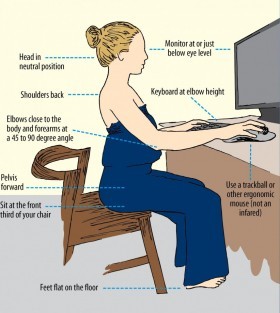 How to Stay Safe
How to Stay Safe
So that was the bad news. But the good news is that avoiding the risks brought on by technology is pretty simple to do. You just have to sit less and move more, and when you are sitting, be mindful that you’re doing it with proper posture.
For every hour that you sit, you need to take a two-minute break to move around to prevent those biochemical processes from breaking down. While you’re moving, do more than take a walk. Do some stretches or some resistance exercises that will also help keep your musculoskeletal system healthy and efficient.
When you sit, you want to make sure to keep an S curvature to your spine. Hunching over technology often puts our body into a C-shaped posture that can increase the sheer force your spine is expected to support. Make sure your chest is up, shoulders are back and down, your pelvis is forward, chin is tucked in, and your feet are flat on the floor.
 Technology: Why We Love It
Technology: Why We Love It
When it comes to technology and your health, it isn’t all bad. In the last few years, there have been some major developments that can actually keep you safe and healthy in this super connected world. Here are some of my favorites:
Healthy Bloggers. Shout out to Dai Manuel! There’s more information and community out there than ever before, so find a blogger that speaks to your personal views on health, and use them as a guide for all things healthy. It’s their job to figure out what’s going on out there and then report it back to you in easy to manage, fun to read, bite-size pieces. Take advantage!
Fitness Apps. Fitness apps are the fastest growing trend in apps today. Your phone can help you diet, exercise, and remind you to move when you've been sedentary too long. With Apple’s new HealthKit on iOS 8, you can compile all of your health and fitness data onto one easy to read screen.
We haven’t seen the last of the research on the negative effects of prolonged sitting, nor have we seen the last of the tech devices that will increase the amount of time you spend being sedentary. Doctors and researchers are now looking at how inactivity affects the brain, creativity, mood, and even cognitive functioning, all while engineers are creating light bulbs and locks that can be controlled by your phone. The take away here is to pay attention, to the research and to your body. If you’re tired, in pain, or getting injured often, there’s probably something you can change to make that better. Dai’s here to help and so am I.
[divider]
 Author Bio
Author Bio
Dr. Gregory Soltanoff is a third generation chiropractor, founder of Voom, a fitness and wellness program designed to change the way we live and work through movement, and author of The Movement Handbook: A cure for our addiction to sitting. He operates two busy practices in upstate New York, where he lives with his wife and two young children.
Social Media: Facebook , Twitter, LinkedIn, and Dr. Greg's Blog
Past articles include:
The Huffington Post - Healthy Living: Your Health in the "it" era
Core Chair Guest Blog: Move more, stress less & Prolonged Siting, Dangerous Workplace
[divider]




































































































